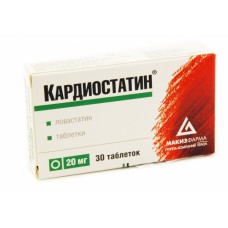Expiration date: 04/2026
The composition and form of issue:
Tablets, 1 tablet contains:
lovastatin 20 or 40 mg
auxiliary substances: lactose, potato starch pregelatinization MCC croscarmellose sodium butiloksianizol calcium stearate
in a contour acheikova packing 10 PCs., in a cardboard 3 bundle packaging.
Description pharmaceutical form:
Tablets white or almost white color, valium forms.
Pharmacological action:
Violates the early stages of cholesterol synthesis in the liver (under mevalonova acid). The body forms the free beta-hydroxy acid, which is competitive ingibiruet g-Koa-reduktazu and violates the synthesis of mevalonate, which reduces the formation of cholesterol and increasing its catabolism. Reduces the blood concentration of VLDL, LDL (including apoprotein and other circulating components), triglycerides, moderately increases the content of HDL.
Pharmacokinetics:
The blood absorbed slowly and incompletely (30% of dose) admission prandial reduces absorption by 30%. Cmax achieved within 2-4 hours, then the plasma is declining rapidly, at 24 h 10% of the maximum. The plasma protein binding is 95%. Biotransformiroetsa in the "first pass" through the liver with the formation of several metabolites, some of which are pharmacologically active (inhibits HMG-COA reductase). Passes through GEB and placental barrier. T1/2 — 3 hours Excreted by the intestine (83%) and kidneys (10%).
Clinical pharmacology:
Pronounced therapeutic effect manifests itself within 2 weeks, the maximum — 4-6 weeks after starting treatment.
Effective in primary hypercholesterolemia patients complicated by insulin-dependent (type 1) and non-insulin dependent (type 2) diabetes.
Indications:
Primary hypercholesterolemia with high LDL type IIA and IIb in the absence of the effect of diet and physical activity, combined hypercholesterolemia and hypertriglyceridemia, coronary atherosclerosis in CHD patients.
Contraindications:
Hypersensitivity, liver disease in the acute phase, increase in liver transaminases, severe General condition of the patient, pregnancy, breast-feeding, age and 18 years (safety and effectiveness in children have not been established).
Application of pregnancy and breast-feeding:
Contraindicated. At the time of treatment should stop breastfeeding.
Side effects:
From the nervous system and sensory organs: dizziness, headache, weakness, seizures, insomnia, paresthesia, mental impairment, "fog" before the eyes, cataract, optic nerve atrophy.
From the cardiovascular system and blood (hematopoiesis, hemostasis): heartbeat, hemolytic anemia, leukopenia, thrombocytopenia.
On the part of the digestive tract: heartburn, nausea, diarrhea, constipation, flatulence, abdominal pain, dry mouth, taste disturbance, anorexia, gastralgia, cholestatic jaundice, hepatitis, acute pancreatitis.
With the genitourinary system: acute renal failure, reduced potency.
From the side of musculoskeletal system: myalgia, myositis, myopathy, rhabdomyolysis (with concomitant use of cyclosporine, gemfibrozil or nicotinic acid), arthralgia.
Allergic reactions: urticaria, angioedema, toxic epidermal necrolysis, pruritus, rash.
The laboratory parameters: increase in liver transaminases, creatine phosphokinase, alkaline phosphatase, bilirubin in serum, eosinophilia, increased erythrocyte sedimentation rate, positive test for antinuclear antibodies.
Other: pain in the chest.
Drug interactions:
Enhances anticoagulant effect of indirect anticoagulants and the risk of bleeding (requires regular monitoring of prothrombin time). Immunosuppressants (including cyclosporin), gemfibrozil, Niacin, erythromycin increases the risk of rhabdomyolysis, acute renal failure. Fibrates, nicotinic acid, Itraconazole and other antifungal agents of the azole group increases the risk of myopathies. Cyclosporine increases the level of metabolites of lovastatin in plasma. Cholestyramine and cholestipol reduce bioavailability (application of lovastatin possible within 4 h after their admission, showing an additive effect).
Method of application and dose:
Inside, during a meal. Hypercholesterolemia: initial dose — 10-20 mg/day (in the evening).
Atherosclerosis: initial dose 20-40 mg/day. If necessary, increase the dose every 4 weeks. The maximum daily dose — 80 mg in 1 or 2 doses (during Breakfast or dinner). By reducing the concentration of total cholesterol in plasma up to 3.6 mmol/l or LDL to 1.94 mmol/l the dose should be reduced.
In concurrent use with immunosuppressants, fibrates, Niacin, as well as in severe renal insufficiency (Cl creatinine < 30 ml/min) the maximum daily dose — not more than 20 mg.
Precautions:
Be used with caution in liver disease (in history), chronic alcoholism, organ transplantation, concomitant immunosuppressive therapy, chronic renal failure, urgent surgical procedures (including dental).
During treatment it is necessary to observe a standard diet low in cholesterol.
With long-term therapy shown biochemical monitoring of liver function: transaminase activity is determined before starting treatment, every 8 weeks during the first year of treatment, further is not less than 1 time in 6 months at a daily dose of 80 mg 1 time in 3 months. With an increase of transaminases (3 times the upper limit of normal) and increasing the level of creatine kinase, the drug should be discontinued.
It is recommended to interrupt treatment or stop medication in General condition of the patient.
When pain in the muscles, pain and weakness of the muscles should consult a doctor.
Special instructions:
If you skip doses of the medication should be taken as soon as possible if time for your next dose, dose not increase.


